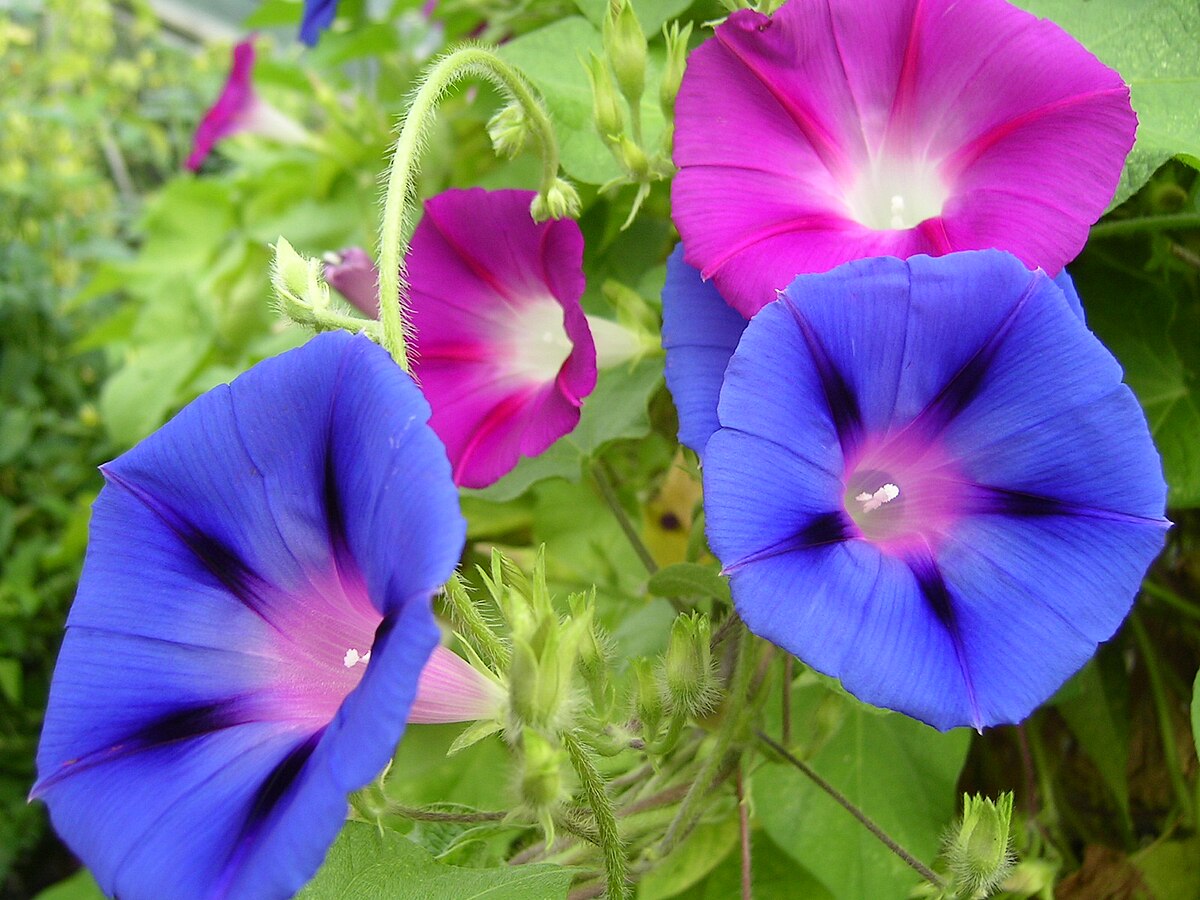Morning Glory vines greet each day with fresh, trumpet-shaped blossoms that unfurl at dawn and close by afternoon. Their rapid growth and eye-catching blooms make them a favorite for trellises, fences, and sunny walls. With hues ranging from deep purple and blue to pink, magenta, and white, they bring charm and whimsy to any garden.
Though these climbers are often grown as annuals, many species are perennial in warmer climates. Whether used to soften hardscapes or add vertical color quickly, Morning Glories reward little care with prolific, cheerful blooms.

Portrait of the Morning Glory
Part of the Convolvulaceae family, Morning Glories include many Ipomoea species, with Ipomoea purpurea being among the most popular in gardens. While their flowers last just a day, new buds open daily in succession throughout the season.
- Type: Annual or perennial climbing vine
- Family: Convolvulaceae
- Common Names: Morning Glory, Common Morning Glory, Blue Dawn Flower
Foliage and Form
Morning Glories feature heart-shaped leaves and slender, twining stems that eagerly climb whatever support they find. They can be trained over arches or left to wander, creating soft, fluttering canopies.
- Height: 2.5–4 m (8–13 ft)
- Spread: 1–2 m (3–6 ft)
- Growth Habit: Fast-growing, twining climber
Blooms and Fragrance
True to their name, Morning Glory flowers bloom with the sunrise and fade by afternoon. Despite their fleeting daily display, their season-long blooming makes them garden stars.
- Bloom Time: June to October
- Color: Blue, purple, pink, red, white
- Fragrance: Generally mild or absent, though some varieties are lightly sweet
The Right Time to Plant, Prune, and Enjoy Morning Glory
| Month | Planting | Flowering | Pruning |
|---|---|---|---|
| January | ❌ | ❌ | ✅ Tidy up old vines (warm zones) |
| February | ❌ | ❌ | ✅ Remove dead growth |
| March | ✅ Start seeds indoors | ❌ | ❌ |
| April | ✅ Direct sow in warm zones | ❌ | ❌ |
| May | ✅ Ideal for outdoor sowing | ✅ Early bloom in hot areas | ❌ |
| June | ❌ | ✅ Peak bloom | ❌ |
| July | ❌ | ✅ | ✅ Light trimming if overgrown |
| August | ❌ | ✅ | ✅ Deadhead for neatness |
| September | ❌ | ✅ (late flush) | ✅ Cut back lightly |
| October | ❌ | ✅ (if warm) | ✅ Remove vines after frost |
| November | ❌ | ❌ | ✅ Clear annual growth |
| December | ❌ | ❌ | ✅ Clean up beds |
✅ = Recommended ❌ = Not advised
🌿 Note: As annuals in most climates, Morning Glory vines will die back after the first frost. In warm zones (USDA 9+), some species may persist as perennials.
Watering, Sunlight, and Environment for Morning Glory
Watering
- Once established, Morning Glories are drought-tolerant and don’t require frequent watering.
- Water regularly while seedlings are young or during dry spells.
When to Water: Every 5–7 days in dry conditions
How Much: Light to moderate, avoid waterlogging
Watch for: Yellowing leaves = possible overwatering
Sunlight
- To get the best flowering, place in full sun—they thrive on bright light.
- Too much shade = more leaves, fewer blooms.
Ideal Exposure: 6–8 hours of sun daily
Shade Tolerance: Low
Indoor vs Outdoor
- Best suited for outdoor spaces where they can climb freely.
- Can be grown in containers with trellises, but indoor flowering is rare.
Best Use: Trellises, fences, archways, containers with support
Avoid: Indoor planting due to lack of light and space
Temperature
- Morning Glory loves warmth and germinates best at 18–24°C (64–75°F).
- Frost-sensitive, so wait until all danger has passed before sowing.
Optimal Range: 20–30°C (68–86°F)
Hardiness Zones: 3–10 (as annual), 9–11 (some perennials)
Frost Warning: Not frost-tolerant
Ideal Soil Conditions for Growing Morning Glory
| Soil Feature | Optimal Condition | Why It Matters |
|---|---|---|
| Soil Type | Loamy or sandy | Ensures good drainage |
| Texture | Light, friable | Helps roots spread quickly |
| Drainage | Well-drained | Prevents root rot |
| Moisture | Moist but not wet | Supports growth without fungal risk |
| Soil pH | Neutral to slightly acidic (6.0–7.5) | Encourages healthy development |
| Fertility | Low to moderate | Too much nitrogen = few flowers |
💡 Tip: Avoid over-fertilizing—this results in lush foliage and few flowers.
Common Problems & Solutions
| Issue 🐾 | Symptoms 🔍 | Solutions 🛠️ |
|---|---|---|
| No Blooms 🌱 | Lots of vines, no flowers | Reduce nitrogen, increase sun exposure |
| Pests 🐜 | Holes in leaves, curled tips | Inspect for aphids or beetles, use soap spray |
| Powdery Mildew 🌫️ | White dust on leaves | Improve air circulation, remove affected parts |
| Weak Growth 🍃 | Thin vines, yellowing | Improve sunlight and soil drainage |
| Invasive Spread 🌿 | Spreads aggressively | Contain in pots or control seed dispersal |
Morning Glory is a gardener’s joy—easy to grow, quick to bloom, and always reaching for the sun. Whether climbing up a mailbox, spilling from a hanging basket, or blanketing a garden wall, it adds vibrant energy and movement to the landscape. With minimal effort, it delivers a season full of color and charm.